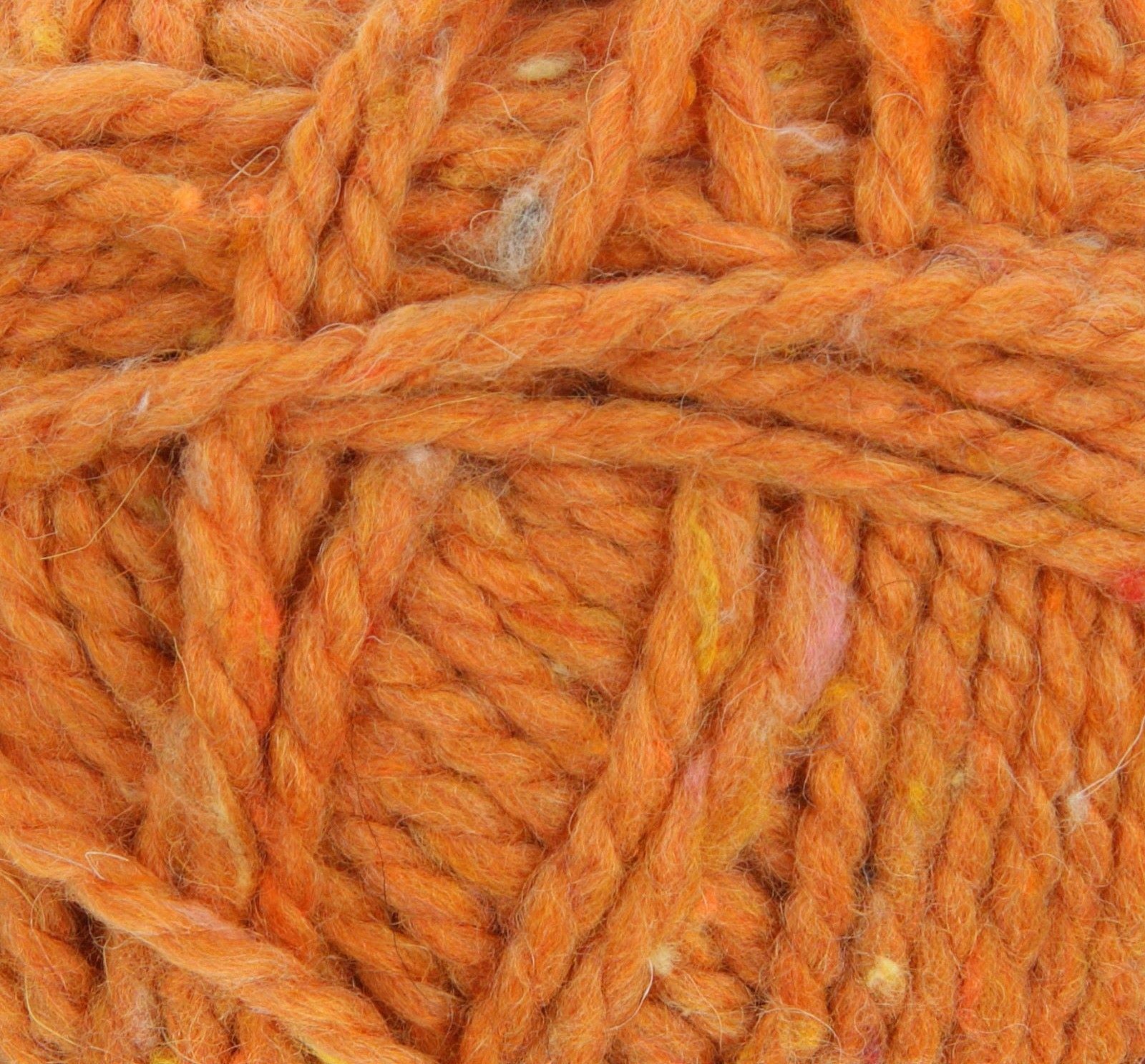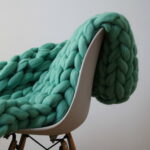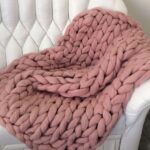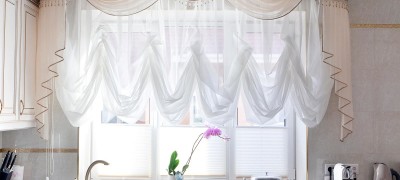Do-it-yourself large-knit plaid
There is nothing more cozy than a blanket. A large knitted handmade blanket is completely out of competition. Even if you do not plan to hide it, just draped over a sofa or bed, it creates an amazing unique atmosphere.
Varieties
It only seems that such an accessory as a plaid does not differ in a wide variety of models. The plaid is appropriate in the bedroom as a traditional bedspread, in the living room such an element will become a spectacular accent, but in the children's room it will harmoniously combine functional and decorative components.

Even in an office, a room with a rather austere interior, a correctly chosen blanket will be able to “register”.
The classification of blankets is very multifaceted. Let's highlight just some of the criteria:
- Factory products and hand-made.
- Solid or multi-colored. Multicolor, in turn, can be divided into contrasting combinations or patterns in the same color scheme.
- Uniform and embossed.
Advantages and disadvantages
Few interior elements so harmoniously combine functionality and striking appearance. A do-it-yourself large-knit plaid is also an exclusive detail that will tell others about your sense of style and needlework skills. The canvas is prized by designers for its versatility, and is usually used as a decorative element:
- Balances the overall color palette of the interior.
- Acts "revitalizing" on boring upholstered furniture.
- In the bedroom, it serves as a spectacular accent in a suitable color.
- Just complements the big picture.
It is difficult to find a more functional thing: you can hide with a blanket during an afternoon rest, or use it instead of a warm sweater for a comfortable pastime in your favorite chair with a cup of coffee. Finally, if the blanket is made of natural wool, do not forget about the healing properties of this material.
Also, the advantages include the ability of knitted fabrics to take almost any shape. The blanket can be conveniently placed both in a baby stroller and on the driver's seat, and every time it will "sit" as if it were knitted according to a pattern.

The disadvantages of such an accessory include the ability to cause allergies (cases are not frequent, there are), the ability to accumulate dust and the need for delicate care. And it's not a secret for anyone that jerseys (both large knitted and not very knitted) are very demanding things to care for. However, true fans of such textiles are sure that the mass of advantages overlaps the disadvantages.
In any case, if you want to extend the lifespan of such an accessory, it is important to remember that knitted blankets need gentle handling.
Another nuisance is the pellets. Unfortunately, knitted blankets retain their original smoothness for a very short time.
How to choose yarn
The right yarn is the key to the success of your knitting project. Moreover, the comfortable operation and service life of the product depend on the yarn. In order not to be mistaken in the choice of threads, you need to decide on the model of the future knitted masterpiece, its size and pattern. And also answer the question: what season is the accessory intended for? Who will be its lucky users?

Pattern is one of the most important factors in yarn selection. There is a sufficient assortment for large knitted blankets.
Natural wool
- Merino - got its name from the breed of sheep, from the withers of which this wool is sheared. Yarn is highly prized because sheep hair is long, bouncy and heat resistant. Sometimes other fibers are added to the merino wool to obtain a budget value.

The yarn is made of wool fibers of a special breed of sheep - Merino. The peculiarity of wool is that it does not cause irritation; even children's things are knitted from it. There is only one drawback: the need for careful maintenance. Merino products are washed only by hand with special means, and dried flat on a horizontal surface.
- Alpaca. This is the wool of llamas. Recently, this type of yarn has become more and more popular, despite the rather high cost. This yarn is very lightweight and durable, almost does not roll or fall off during wear. Alpaca wool products are very warm, and thanks to the rich assortment of yarns, it is easy to choose the design of the future blanket.

Alpaca is a quality yarn. It is very soft and lightweight. The disadvantages include the high cost: if the blanket is made of 100% alpaca wool, then the blanket will cost fabulous money. In addition, the natural canvas turns out to be prickly. To avoid this, choose yarn with the addition of synthetic or merino yarn.
Finally, alpaca is the moth's favorite treat, but mothballs cannot be used. Therefore, to protect things from being eaten, use natural repellents such as lavender, cedar or tobacco.
- Mohair. Natural mohair is a yarn made from wool of angora goats, very soft, fluffy, hypoallergenic, and at the same time strong and durable. Products made from such threads can withstand many washings and at the same time remain the same fluffy and shiny.

This type of yarn is made from angora goat fur. It is believed that mohair is suitable for the work of beginner knitters, since the fabric turns out to be voluminous and fluffy, which means that some flaws will be simply invisible. The disadvantages include the cost of the yarn.
Very expensive 100% mohair, and if it is 10-20% in the yarn (which, in general, is enough for warmth and fluffiness), then the cost of the yarn will be much lower.
- Angora rabbit wool. Feels like the yarn is very similar to mohair. The main advantage is low weight, so very little of it is required for a full-fledged product. But this is provided that you have pure Angora rabbit wool in your work without any impurities.

Angora rabbit wool threads are incredibly soft and warm. An obvious drawback is that pellets appear quickly, and the product, figuratively speaking, peels off. If the thing that has just been knitted looks velvety, then with regular use (wear) it very quickly takes on a somewhat sloppy look due to the pellets, and the touch ceases to be the same velvety.
If you knit a blanket from angora, then it is better to use it only on special occasions, and not as an everyday option.
Synthetics
- Acrylic. Recently, this yarn has become more and more popular. A blanket knitted from acrylic threads turns out to be as warm as a woolen blanket, and at the same time does not prick at all. Products made of acrylic do not require special care, they can be washed even in a machine, and the appearance of pellets is practically excluded.

Acrylic yarn is very easy to work with. In addition, the product retains its original color for a very long time, which means that after tying (or buying) a bright blanket, you should not worry that after a few washes it will lose its original beauty. Affordable price is another indisputable advantage of acrylic yarn. The only downside is that few people like synthetic fabrics, and it can be too hot under such a blanket, since acrylic does not allow air to pass through.
- Nylon.It is better not to use this material in its pure form for a blanket, but completely as an additive. Nylon will add strength to the product and make it a little cheaper.

Nylon yarn is an inexpensive and reasonably strong material. - Microfiber. Although this material is synthetic, it differs from acrylic in good breathability. Microfiber is often used to knit blankets with a decorative pattern. The product is not deformed after washing.

After washing, the yarn retains its properties, but after prolonged use it begins to frizz. The only drawback is that after prolonged use, the canvas begins to fluff, and it is no longer possible to return the product to its original appearance.
- Blended yarn. Perhaps the perfect option for a blanket. Natural fibers reinforced with worthy qualities of synthetics give excellent results.

Blended yarn is a yarn made of cotton and polyester. The proportions may vary. Blankets are warm, pleasant to the touch, wear-resistant, and breathable. And all this splendor is offered at an affordable price.
Advice. Well, if you want something very unusual, bouclé yarn, sequin and lurex threads, sectional dyeing yarn and much, much more are at your service.
How much yarn, what time
Usually, to knit a blanket with your own hands, use a woolen or semi-woolen merino roving without twisting or a felted ribbon. There are craftswomen who like to knit blankets from knitted yarn more. Although, according to others, such products are not soft and comfortable enough.
Hand knitting yarn has two types of markings: in grams and in meters. In the offered master classes, you can rarely find the number of skeins. And each knitter has her own system for determining the required number of threads: it is easier for someone to navigate in grams, while someone prefers to calculate by footage. This is already a matter of personal preference.
On average, for a small baby blanket measuring 80x120 cm, you will need 2 kg of merino fiber. We emphasize that this is an average value. Adult rectangular products close to the standard, measuring 100x150 cm, will require approximately 3 kg of yarn. Well, if you decide to knit a bedspread on a wide double bed (150x200 cm), then you need to have about 6 kg of wool in stock.

The main advantage of bulky knitted blankets is that such a product can be knitted in just a few hours. Moreover, today technologies are available in which no tools are required for knitting: only hands and yarn (no crochet, no knitting needles!). And even novice craftswomen can do this.
Large knitted blankets do not require sophisticated patterns, very often the pattern is a front surface. Therefore, the answer to the question: how to make a blanket is extremely simple. Indeed, in order to knit the fabric with the front satin stitch, the skills of a professional knitter are not required.
A chunky knit blanket, regardless of whether it is knitted by your hands or purchased, is always a spectacular accent in the interior. Correctly chosen yarn will make it a functional accessory, and a spectacular color scheme will add zest to the design of the room.
Video: how to knit a large knit plaid?

















